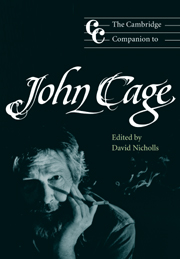7 - Visual art
from Part II - Sounds, words, images
Published online by Cambridge University Press: 28 September 2011
Summary
John Cage's visual art, done in the last section of his life, is a collection of forms whose purpose, he often said, is “to sober and quiet the mind.” Cage developed his art with sustained attention, and it became original on its own terms. In a purely visual way it gives a sense of the direction and meaning of his mature thought.
Cage was sixty-five years old when, in 1977, I invited him to come to Oakland, California, to work with our printers at Crown Point Press to make etchings. In reply to my invitation, he told me that he had promised the composer Arnold Schoenberg (in 1934), as a condition of studying with him, to devote his life to music. And then he added another story. He had once received an invitation from a friend to walk with her in the Himalayas, and he had not accepted. “I have always regretted this,” he added.
Because of that regret, he accepted my invitation, and beginning in January 1978, he worked with us for a week or two almost every year, fifteen times before his death fifteen years later. At Crown Point Press, which is now located in San Francisco, Cage produced twenty-seven groups of prints, mainly etchings, and these groups contain all together 667 individually composed works of art. Cage had begun his work as a visual artist in 1969 in New York with a print project, but it was nine years later, with his first Crown Point visit, that his sustained art activity began.
- Type
- Chapter
- Information
- The Cambridge Companion to John Cage , pp. 109 - 127Publisher: Cambridge University PressPrint publication year: 2002
- 1
- Cited by



